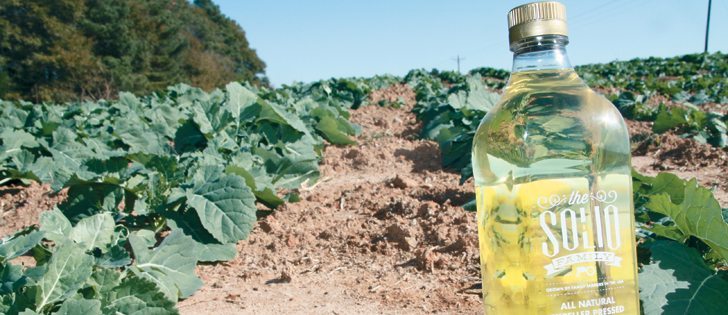Canola has long been seen as a good winter seeded crop in local rotations in Georgia and other southeastern U.S. states. But lack of markets held it back — until now. Growers are now seeding non-genetically modified varieties to serve a niche food market, while the meal is going to the booming local poultry industry. A proposed bioplastics plant would further boost acreage. This beachhead in the American South could be good for Canadian growers, too, by expanding the canola consumer base and providing experience and data in alternative production systems, such as row crop seeding with planters. Western Producer reporter Robert Arnason takes a look at the fledgling canola industry in Georgia in this Special Report.
Read Also

Chinese, Indian tariffs take toll on pea prices
The disruption of pea exports from Canada’s largest customers will likely result in slow pea exports for the remainder of the crop year.
RESACA, Ga. — It’s hard to imagine while driving down a gravel road in northwestern Georgia that people grow crops here.
Trees and homes on quarter acre lots line both sides of the road, and it’s difficult to see more than 500 metres in any direction.
However, the sight lines suddenly open up three kilometres east of Resaca, which is 120 km from Atlanta, and the trees give way to farmland.
Grain bins and a feed mill are visible down the gravel road, confirming it is possible to grow crops in this area.
In fact, the river valleys and other pockets of agricultural land in this part of Georgia are productive, particularly for winter canola.
Growers in the region, near the Chattahoochee National Forest, regularly produce canola yields of 50 to 60 bushels per acre.
Dozens of farmers in the northern half of the state are growing winter canola, which is surprising be-cause as recently as 2006 there was almost none.
Andrew Moore, who farms with his father, grandfather and uncle near Resaca, is one of those credited with resurrecting canola in the state.
The Moores grew winter canola in the 1980s and early 1990s, when University of Georgia extension personnel promoted the oilseed as an alternative winter crop.
The university even had a full-time canola breeder because many people expected canola acres to boom in the southeastern United States.
However, local markets for canola disappeared in the 1990s after a canola crushing co-operative in central Georgia never materialized.
The Moores and other farmers who liked growing canola abandoned the crop. By the early 2000s, Georgia’s canola dream was dead.
However, Andrew’s father, Joe, took a trip to Minnesota in 2006 and met a farmer who was crushing canola on his farm with a cold pressed expeller.
The new knowledge inspired the Moores to try something similar. They planned to convert canola oil to biodiesel to power tractors on their farm.
“In 2006, we put in a pilot plant and started processing about 18 tons of canola per day. The canola came from our farm,” he said while standing near a trailer that serves as an office for Resaca Sun, the name of the Moore’s oilseed processing business.
“That was the first canola grown in Georgia in quite a long time.”
Just behind where Moore was standing was a connection to Manitoba: a plastic guard for a MacDon combine header.
The Moores followed up their initial experiment by expanding their operations in 2008. They now operate a 50 ton per day expeller press and a feed mill and grow 500 acres of winter canola.
They also process soybeans and sunflowers, but the focus is canola.
During the last seven years, they have convinced farmers in northern Georgia, nearby Tennessee and Alabama to grow winter canola once again or try it for the first time.
One of Moore’s partners in the business, Robert Davis, left around 2009 to start his own canola processing enterprise in Bowersville, Ga., 200 km northwest of Atlanta.
Davis and his cousin formed AgStrong and began holding meetings to sell farmers on canola.
One of their first converts was Russ Moon, who farms near Athens, Ga.
“It’s good for our rotation,” said Moon, who grows winter canola on a three-year rotation and dedicates one-third of his 1,300 acres to the oilseed.
“We can’t plant wheat after wheat and wheat.”
AgStrong also convinced Kevin Rentz, who farms in Branson, Ga., near the Florida border, to take a chance on canola five years ago.
“I started growing it because wheat prices were in the dumps,” said Rentz, who grows cotton and peanuts in the summer and canola and wheat in winter.
“I needed to find a different crop.”
His first experiment with 70 acres of canola was a flop because a spring windstorm wiped out half of the crop.
However, the second year was more encouraging.
“We averaged close to 50 bu. and the price was really good. I think I sold it for around $15 per bu.”
AgStrong has also reached outside of Georgia to attract canola production. A number of South Carolina farmers are now growing winter canola and selling it to the company.
“We’ve always been able to grow canola in South Carolina, but we didn’t always have a market for it,” said Trish Dehond, an agriculture extension rep for Clemson University in Darlington County, S.C.
“Now we have a market for it.”
South Carolina farmers also grew canola in the 1980s and 1990s, but it died off when local buyers vanished.
The crop competes with winter wheat for acreage in Georgia,
South Carolina and other parts of the southeast, and the battle comes down to basic economics.
“It’s all down to business at the end of the day.… It’s all about profitability per acre,” said Brian Caldbeck, who runs Rubisco Seeds, a hybrid canola seed dealer in Kentucky.
“Here (in Kentucky), we’re in a heavy double crop rotation. When we harvest the winter canola, we turn around and plant the Roundup Ready soybeans…. The way we look at it, 50 to 60 bu. winter canola is the much the same as 80 bu. wheat for the revenue. If we can’t make 50 to 60 bu. … they (farmers) are not going to grow it.”
Caldbeck, who specialized in winter oilseeds in Europe before leaving Ireland for the United States 10 years ago, said Kentucky farmers have been growing winter canola for more than a decade.
However, they had to ship it to an ADM crushing plant in Windsor, Ont., before AgStrong and Resaca Sun were formed.
AgStrong announced plans last spring to build a $7.3 million, 150 ton per day canola processing plant in Trenton, Ky.
Meredian Holdings Group is also investing in canola processing in the southeastern U.S. It is building a plant to turn canola oil into bioplastics in Bainbridge, Ga., near the Florida border.
The company contracted 5,000 acres of canola in southwestern Georgia this fall and has ambitious expansion plans. Meredian will need 100,000 acres of canola to supply its bioplastics production when it reaches full capacity.
Private investors in the southeastern U.S. may feel optimistic about canola, but the industry is tiny compared to Western Canada. C rushing plants are small and the U.S. Department of Agriculture doesn’t even track canola acres in the region.
Moore said planted area estimates range from 15,000 to 60,000 acres, and Resaca Sun, AgStrong and Meredian will need much more than 60,000 acres to run at full capacity.
Processors will have to convince more farmers to grow winter canola, which isn’t a sure thing.
“Moving a producer from wheat is somewhat tough,” said Moore, a director with the U.S. Canola Association. “Changing the average southern farmer (is not easy).”
Nonetheless, Moore said canola has a bright future in the southeast.
“I believe that North Dakota and Minnesota (canola) … is now in a battle for acreage (with soybeans and corn),” he said.
”It’s hard to believe there’s going to be an expansion in that area.”
Winter canola has exploded in Oklahoma, Kansas and Texas, going from nothing to 300,000 acres in short order. However, acreage fell this fall after freezing weather and a winter drought hammered yields last year.
“You can’t grow anything … when you get five inches of rain per year,” Moore said. “I believe the expansion of acres in the U.S. is going to be in the southeast…. If we had a big buyer, ADM, Bunge, Cargill, any of those companies come in and say, ‘we want to put in a canola processing facility or convert one’ … you would see a dramatic increase in canola acres.”
Moon isn’t convinced canola will boom in Georgia. He said it is unlikely to become a big acreage crop comparable to cotton or peanuts.
“It’s going to be a fit for certain farmers, (but) I think (acres) can slowly grow,” he said.
“As long as we’re making money on it, it will continue to grow.”
Moore agreed canola acreage in the southeastern U.S. will never compare to Western Canada, but a steady acreage expansion should boost canola’s profile in places like Georgia, South Carolina and North Carolina, which are home to 25 million people.
If a larger percentage of those consumers become aware of the crop it should benefit canola growers across North America, including those in Western Canada.
















